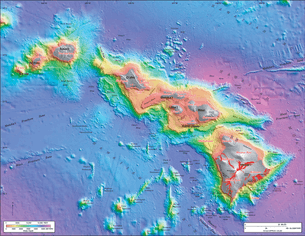Maui Nui
Maui Nui or Greater Maui, is a modern geologists' name given to a prehistoric Hawaiian Island built from seven shield volcanoes. Nui means "great/large" in the Hawaiian language.


1.2 million years ago, Maui Nui was 14,600 square kilometres (5,600 sq mi),[1] 40% larger than the present-day island of Hawaiʻi. Sea levels were lower than today's, due to distant glaciation locking up the Earth's water during ice ages, thus exposing more land. As the volcanoes slowly settled by subsidence, due to the weight of the shield volcanoes and erosion, the saddles between them slowly flooded, forming four islands: Maui, Molokaʻi, Lānaʻi, and Kahoʻolawe by about 200,000 years ago. Another former volcanic island lying west of Molokaʻi was completely submerged, and covered with a cap of coral; it is now known as Penguin Bank.
The sea floor between these four islands is relatively shallow, about 500 metres (1,600 ft) deep, and all of the islands except Kahoʻolawe were joined during the low sea levels of the last glacial maximum, about 20,000 years ago. But at the outer edges of former Maui Nui, as with the edges of all Hawaiian Islands, the sea floor plummets to the abyssal ocean floor of the Pacific Ocean. The steep slopes can result in massive landslides due to flank collapse, including one which removed most of the northern half of East Molokaʻi.
Administratively, the current islands remaining from Maui Nui comprise Maui County (except a tiny part of Molokaʻi, which comprises Kalawao County).
Maui Nui was formed in the Pleistocene Epoch (or period of time) which lasted from around 2 million years ago to about 11,000 years ago.
References
- "Once a big island, Maui County now four small islands". Volcano Watch. Hawaiian Volcano Observatory. 2003-04-10. Retrieved 2009-02-27.